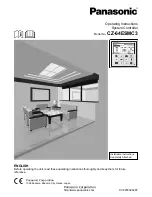
CHAPTER 5: SETTINGS
INPUTS/OUTPUTS
M60 MOTOR PROTECTION SYSTEM – INSTRUCTION MANUAL
5-319
5
A time stamp of the first sample in the sequence that validates the new state is used when logging the change of the
contact input into the Event Recorder (mark no. 2 in the figure).
Protection and control elements, as well as FlexLogic equations and timers, are executed eight times in a power system
cycle. The protection pass duration is controlled by the frequency tracking mechanism. The FlexLogic operand reflecting
the debounced state of the contact is updated at the protection pass following the validation (marks no. 3 and 4 on the
figure that follows). The update is performed at the beginning of the protection pass so all protection and control functions,
as well as FlexLogic equations, are fed with the updated states of the contact inputs.
The FlexLogic operand response time to the contact input change is equal to the debounce time setting plus up to one
protection pass (variable and depending on system frequency if frequency tracking enabled). If the change of state occurs
just after a protection pass, the recognition is delayed until the subsequent protection pass; that is, by the entire duration
of the protection pass. If the change occurs just prior to a protection pass, the state is recognized immediately. Statistically
a delay of half the protection pass is expected. Owing to the 0.5 ms scan rate, the time resolution for the input contact is
below 1 ms.
For example, eight protection passes per cycle on a 60 Hz system correspond to a protection pass every 2.1 ms. With a
contact debounce time setting of 3.0 ms, the FlexLogic operand-assert time limits are: 3.0 + 0.0 = 3.0 ms and 3.0 + 2.1 = 5.1
ms. These time limits depend on how soon the protection pass runs after the debouncing time.
Regardless of the contact debounce time setting, the contact input event is time-stamped with a 1
μ
s accuracy using the
time of the first scan corresponding to the new state (mark no. 2 shown). Therefore, the time stamp reflects a change in the
DC voltage across the contact input terminals that was not accidental as it was subsequently validated using the
debounce timer. Keep in mind that the associated FlexLogic operand is asserted/de-asserted later, after validating the
change.
The debounce algorithm is symmetrical: the same procedure and debounce time are used to filter the LOW-HIGH (marks
no.1, 2, 3, and 4 in the figure) and HIGH-LOW (marks no. 5, 6, 7, and 8) transitions.
Figure 5-180: Input contact debouncing mechanism and time stamp sample timing
Contact inputs are isolated in groups of four to allow connection of wet contacts from different voltage sources for each
group. The
CONTACT INPUT THRESHOLDS
determine the minimum voltage required to detect a closed contact input. This
value is selected according to the following criteria: 17 for 24 V sources, 33 for 48 V sources, 84 for 110 to 125 V sources
and 166 for 250 V sources.
Содержание M60
Страница 9: ...TABLE OF CONTENTS M60 MOTOR PROTECTION SYSTEM INSTRUCTION MANUAL ix INDEX ...
Страница 10: ...x M60 MOTOR PROTECTION SYSTEM INSTRUCTION MANUAL TABLE OF CONTENTS ...
Страница 14: ...1 4 M60 MOTOR PROTECTION SYSTEM INSTRUCTION MANUAL FOR FURTHER ASSISTANCE CHAPTER 1 INTRODUCTION 1 ...
Страница 208: ...4 88 M60 MOTOR PROTECTION SYSTEM INSTRUCTION MANUAL FLEXLOGIC DESIGN USING ENGINEER CHAPTER 4 INTERFACES 4 ...
Страница 494: ...5 286 M60 MOTOR PROTECTION SYSTEM INSTRUCTION MANUAL CONTROL ELEMENTS CHAPTER 5 SETTINGS 5 Figure 5 158 Time out mode ...
Страница 552: ...5 344 M60 MOTOR PROTECTION SYSTEM INSTRUCTION MANUAL TESTING CHAPTER 5 SETTINGS 5 ...
Страница 596: ...7 14 M60 MOTOR PROTECTION SYSTEM INSTRUCTION MANUAL TARGETS MENU CHAPTER 7 COMMANDS AND TARGETS 7 ...
Страница 602: ...9 4 M60 MOTOR PROTECTION SYSTEM INSTRUCTION MANUAL SATURATION DETECTOR CHAPTER 9 THEORY OF OPERATION 9 ...
Страница 652: ...C 6 M60 MOTOR PROTECTION SYSTEM INSTRUCTION MANUAL COMMAND LINE INTERFACE APPENDIX C COMMAND LINE INTERFACE C ...
Страница 660: ...iv M60 MOTOR PROTECTION SYSTEM INSTRUCTION MANUAL ABBREVIATIONS ...
















































